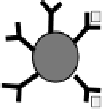Biomedical Engineering Reference
In-Depth Information
Bioreceptor-coated
sensing substrate
Exposure to
sample
Measurable signal
produced upon binding
Signal
transduction
Analyte
bound
Probing
energy
No analyte
Wavelength (nm)
Selective binding of
analyte
FIGURE 3.1
Schematic diagram depicting the fundamental concept of a biosensor. A bioreceptor is used to provide specific
chemical recognition, followed by probing of this interaction to provide a measurable signal.
of an array of individual biosensors that can be individually monitored and used to detect
multiple analytes simultaneously.
3.1.1
Beginnings of Optical Nanosensor
Since the first integrated macroscopic biosensors were reported in the early 1960s,
22
there
has been a constant desire to reduce the size of these sensors to take advantage of signifi-
cant enhancements in sensitivity, response time, and many other important characteristics
while still retaining the specificity and sensitivity derived from using biological receptor
molecules or organisms. In the early 1990s, the fields of chemical and biochemical sensing
experienced several simultaneous advances that allowed for the realization of optical
nanosensors. Chief among these advances was the development of tapered probes for near-
field-scanning optical microscopy (NSOM).
23
NSOM is a relatively new technique, employ-
ing light sources and detectors that are smaller than the wavelength of light used for
imaging, allowing for chemical images of a sample to be taken with nanometer-scale (i.e.,
10-50 nm) spatial resolution.
23-26
One common method for performing such measurements
is to construct an excitation probe with dimensions that are smaller than the wavelength of
light that is being used for sample interrogation, effectively providing a light source with
subwavelength dimensions.
27,28
The first such excitation probe was developed by Betzig et
al.
27
by tapering a single-mode optical fiber to dimensions of approximately 20 nm, thereby
confining the excitation radiation to the fiber tip. Using such tapered optical fibers, Betzig
and coworkers
24,25,29,30
were able to reconstruct chemical images of a known pattern, with
signal enhancements of greater than 10
4
over previous NSOM analyses that employed
apodized detectors. Since then, tapered fiber-optic probes have been used by many
researchers for the analysis of a wide variety of samples, including the imaging of

























